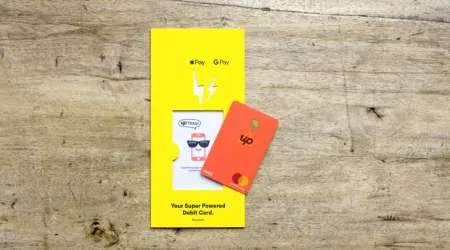- No minimum deposits
- No ATM fees
- Apple Pay & Google Pay
We’re reader-supported and may be paid when you visit links to partner sites. We don’t compare all products in the market, but we’re working on it!
Not 100% sure what a neobank is? Don't worry, you're not the only one. Consider neobanks to be the future of banking - they only operate online and use next-gen technology to help make saving and spending easy. Most neobanks have some pretty good perks attached, like the ability to set up multiple savers tailored to your savings goals, be reminded about upcoming bills, integration of cloud technology to see your whole financial picture, and so, so much more.
Let's dive into some of the most popular Australian neobanks, see what makes them unique, and get you saving sooner.
Compare some leading Aussie neobanks
What is a neobank?
Like the name suggests, a digital bank operates digitally, usually from an app, rather than from a physical branch or office. A digital bank is a fairly loose term; the correct industry name for these banks is a neobank.
A neobank is a completely digital bank that doesn't use any existing legacy systems to operate. This means the bank doesn't use any physical infrastructure or digital operating systems that are already being used by existing financial institutions in Australia. The technology used by these neobanks is developed from scratch. It's a bank that operates via an app on your phone.
What's the difference between a digital bank and a traditional bank that's available online?
Many banks in Australia appear to be digital banks since they don’t have branches and are focussed on developing top quality mobile banking apps for their customers. However, just because a bank doesn’t have branches and offers a range of digital products and platforms doesn’t mean it’s a digital bank or a neobank.
A bank offering Apple Pay isn't necessarily a digital bank.
Many banks offer contactless payments via digital wallets like Apple Pay, Google Pay and Samsung Pay. Westpac is the oldest bank in Australia and it offers Google Pay to its customers, yet Westpac isn’t considered to be a completely digital bank.
Similarly, if a bank offers a top-notch mobile banking app, Internet banking services, cardless cash facilities and digital savings tools, this doesn’t automatically mean it’s a digital bank either. Remember, a 100% digital neobank is one that doesn’t use any existing banking systems or infrastructure.
ING, ME and UBank aren’t 100% digital banks.
Many people refer to ING and ME as digital banks because they don’t have any physical branches. However, these banks aren’t neobanks because they rely on existing banking infrastructure.
For example, ING is owned by multinational Dutch bank ING Group and relies on its infrastructure and legacy systems to operate. ME is owned by more than 20 industry superannuation funds, including AustralianSuper and Hostplus. Similarly, UBank is actually owned by NAB, one of the Big Four banks in Australia, and relies on a lot of NAB’s existing operating systems to function.
That's not to say that these banks don't offer great digital services, because they do. ING has one of the most popular banking apps, and UBank is known for its easy-to-use app with spending insights too. It just means these banks aren't considered neobanks in the traditional sense.
Are digital banks safe?
Digital banks need to have the same banking licences and approvals as existing Australian banks before they’re able to offer products and services to consumers. These new banks are regulated by the Australian Prudential Regulation Authority (APRA) and the Australian Securities and Investment Commission (ASIC) in a similar way to how existing banks are regulated.
Your deposit of up to $250,000 with an Australian authorised deposit-taking institution (ADI) is protected by the Australian government, under the financial claims scheme. This means if something were to happen to the bank, your money (up to this amount) would be safe.
When a digital bank receives its full ADI license from APRA, it's included in the government guarantee scheme and your deposit is protected. Xinja, Volt and 86 400 have all received their full ADI banking licenses, so you're deposit up to $250,000 with these banks is protected. Up Bank uses the ADI license of an existing bank (Bendigo and Adelaide Bank) so your deposit with Up is also guaranteed.
Note that some of the digital banks mentioned in this guide (for example Revolut) are not yet considered banks (they aren’t ADIs) and don't yet have a banking licence from industry regulators.
Mobile-only banks vs online banks
Mobile-only banks are designed to be accessed from an app on your smartphone. Unlike traditional banks, there are no bank branches and unlike online bank there's no option of Internet banking via a desktop. While mobile-only banks and online banks seem similar, there are a few key differences that set them apart.
- Access. Mobile-only banks are called as such because you can only access them through your smartphone or, sometimes, your tablet device. Other online banks such as ING and ME still offer Internet banking portals that you can access on your computer. They are "online banks" because they simply have no bank branches and you can access them online.
- Technology. Some online banks are part of larger international finance groups (ING) or using the infrastructure of big banks (UBank and NAB). Mobile-only banks may still partner with larger banks, but are usually building their own bank from the ground up to be able to be nimble with their products and features.
- Product offerings. Online banks such as ING, ME and UBank have been around for a lot longer than mobile-only banks and so have a more diverse product offering. For instance, ME offers bank accounts, home loans, credit cards and personal loans and ING has a similarly diverse offering. Mobile-only banks, for now, tend to only offer one or two products.
Pros and cons of a digital bank
Pros
- Impressive apps packed full of features
- Detailed insights into your spending and saving habits
- Competitive interest rates and low or no fees
Cons
- Some only offer one product, so you can't do all your banking with a digital bank just yet
- No branches for people who like to visit a branch, and no desktop Internet banking portal either
How to get started with a neobank
If you’re interested in joining one of these new neobanks, all you need to do is download their app to get started. These apps are free to download. Once you've got the app, just follow the prompts to create an account and verify your identity.
Then you're done! You'll receive your physical debit card in the mail, but you can also start using the account right away.
Watch our interview with 86 400 co-founder Anthony Thomson and digital banking expert Chris Skinner.
Latest news in digital banking

Volt joins fellow neobanks and announces a cut to its savings rate
The total interest rate on the Volt Save account will be cut by 20 basis points, from 1.45% p.a. down to 1.25% p.a.
Read more…
86 400 customers can now see Zip transactions in their banking app
Customers of Aussie neobank 86 400 will be able to see (BNPL) purchases within their own bank accounts thanks to a new partnership with Zip.
Read more…
Here’s why Australians are flocking to the new digital banks
Hundreds of thousands of consumers are taking their money over to challenger banks Judo, Xinja, Up and Volt.
Read more…
Why Up bank hasn’t launched a credit card or mortgage, yet
Digital bank Up says a credit product is on the horizon, but it won't be launching one any time soon.
Read more…
Podcast: How Up is building a bank for Generation Z
Up co-founder Dominic Pym joins us to chat about the bank's slick branding, engaging customer experience and attitude towards technology.
Read more…More guides on Finder
-
Xinja Stash account review
Xinja Stash is a high-interest savings account with no deposit conditions to meet. Link the account to a Xinja bank account.
-
Volt Save Account Review
The Volt Savings Account offers a competitive variable interest rate on your savings with no monthly deposit conditions to meet and no withdrawal restrictions.
-
86 400 Save account review
The 86 400 savings account offers a high bonus interest rate and charges no fees. You'll get notification reminders when you're not on track to earn the bonus interest, but you need an 86 400 Pay account.
-
86 400 Pay account review
The 86 400 bank account has no account-keeping fees and offers smart spending tools and features within the 86 400 app as well as Apple Pay, Google Pay and Samsung Pay.
-
Xinja bank account review
Digital bank Xinja's bank account is an everyday transaction account with zero ATM fees, zero account fees and no currency conversion fees. Track your spending in the app with spending categories.
-
Pelikin travel card review
Pelikin is a prepaid multi-currency travel card and app that could save you money when travelling overseas. Here's all the details of the account.
-
QPay review
QPay is the prepaid spending card and app used by students across Australia. Find out how it works and if it's right for you.
-
Revolut Australia
Revolut is available for download in Australia. This review will tell you what you need to know about the multi-currency account before you sign up.
-
Xinja Bank products
Considering signing up for Xinja? Find out what you need to know about this (soon to be) digital bank's prepaid card and pre-beta home loan as well as its other upcoming products.
Ask an Expert


I would like to reach out to you to find out if there is a saturation point for digital banking. Please advice
Kind regards
Hi Gladys,
Thank you for reaching out to Finder.
Yes, there may be a saturation point for digital banking but this is not something to be worried about in Australia. The saturation point for neobanking is currrently seen in the US where new app growth has slowed, business mobile has failed to grow as expected, person-to-person growth is low and debit card controls are gaining popularity.
Hope this helped.
Kind Regards,
Mai